|
Breakwaters
These random blogs are going to always be known as "The Awake
Worrying About Kate" blogs. Kate has Phaeochromocytoma, rare as hen's teeth,
this has made her into a national celebrity, getting Consultants as far as
Glasgow scratching their heads. Oh for a simple life. Toes are crossed now.
Breakwaters are structures constructed on coasts as part of coastal
defense or to protect an anchorage from the effects of weather and long shore
drift, creating safe harbours.
Purposes of breakwaters
Offshore breakwaters, also called bulkheads, reduce the
intensity of wave action in inshore waters and thereby reduce coastal erosion.
They are constructed some distance away from the coast or built with one end
linked to the coast. The breakwaters may be small structures, placed one to
three hundred feet offshore in relatively shallow water, designed to protect a
gently sloping beach. Breakwaters may be either fixed or floating: the choice
depends on normal water depth and tidal range. When oncoming waves hit these
breakwaters, their erosive power is concentrated on these structures some
distance away from the coast. In this way, there is an area of slack water
behind the breakwaters. Deposition occurring in these waters and beaches can be
built up or extended in these waters. However, nearby unprotected sections of
the beaches do not receive fresh supplies of eroded sediments and may gradually
shrink due to erosion. Breakwaters are subject to damage, and overtopping by big
storms can lead to problems of drainage of water that gets behind them. The wall
also serves to encourage erosion of beach deposits from the foot of the wall and
can increase long shore sediment transport.
 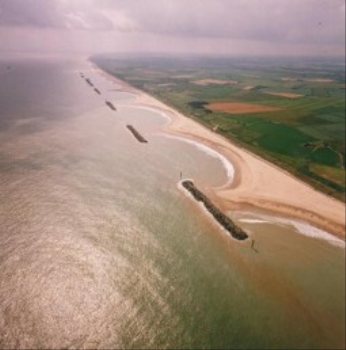 
The old fashioned breakwaters we
remember from trips to the seaside as children, Plymouth
breakwaters and a good shot of how sand and sediment fills in behind,
shaped by the sea. Sampson breakwaters with the
strategically placed outer wall.
Protection of anchorages
An anchorage is only safe when ships anchored there are
protected from the force of high winds and powerful waves by some large
underwater barrier which they can shelter behind. Natural harbours are formed by
natural barriers such as headlands or reefs. Mobile harbours, such as the D-Day
Mulberry harbours were floated into position and acted as breakwaters. Some
natural harbours, such as those in Plymouth Sound, Portland Harbour and
Cherbourg, have been enhanced or extended by breakwaters made of rock.
 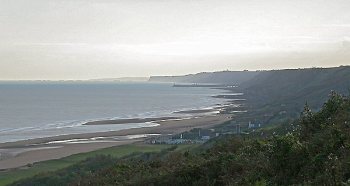
The Mulberry Harbours of D-Day. What is
left of them today
Clapotis (I just love this word) is seen
rather frequently in front of a quay or breakwater with vertical walls. Incoming
waves are reflected by the wall and their direction is reversed. But since the
reflected waves have amplitudes opposite to those of the incoming waves, the two
waves simply cancel each other out and what is left is a relatively flat sea.
The clapotis is what remains after the imperfect cancellation of the incoming
and reflected waves. It occurs because the period and direction of incoming
waves is always a little variable. Any shape breakwater might seem to be an
ideal way to calm the sea at the entry to ports, and many breakwaters have been
constructed using the principle of cancellation of waves by reflection.
Unfortunately, during big storms the stresses on the walls are so great that
they can be swept away. Current practice is to absorb the incoming waves rather
than try to reflect them.
 
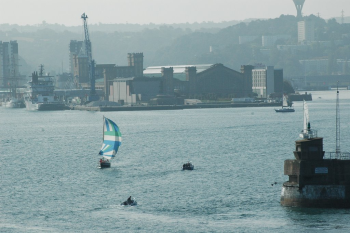
Plymouth Sound, Portland Harbour and
Cherbourg
Types of breakwater structures
A breakwater is constructed some distance away from the coast
or built with one end linked to the coast. Breakwaters may be either fixed or
floating: the choice depends on normal water depth and tidal range. A breakwater
structure is designed to absorb the energy of the waves that hit it. This is
done either by using mass (e.g. with caissons) or by using a revetment slope
(e.g. with rock or concrete armour units).
Caisson breakwaters typically have vertical sides and are
usually used where it is desirable to berth one or more vessels on the inner
face of the breakwater. They use the mass of the caisson and the fill within it
to resist the overturning forces applied by waves hitting them. They are
relatively expensive to construct in shallow water, but in deeper sites they can
offer a significant saving over revetment breakwaters.
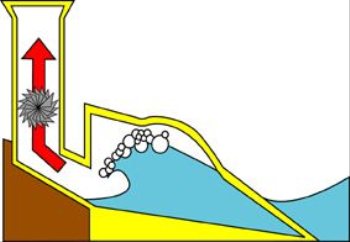

Examples of Caisson construction
Rubble mound breakwaters use the voids in the structure to
dissipate the wave energy. Rock or concrete armour units on the outside of the
structure absorb most of the energy, while gravels or sands are used to prevent
the wave energy continuing through the breakwater core. The slopes of the
revetment are typically between 1:1 and 1:2, depending upon the materials used.
In shallow water revetment breakwaters are usually relatively cheap, but as
water depth increases, the material requirements, and hence costs, increase
significantly.
Tetrapods meaning four-footed are the curious shaped
objects we have seen in so many harbour walls and breakwaters. Here in Agadir
for example. They are designed to absorb the energy of waves striking a
breakwater. When piled up, they provide a great many small spaces the waves can
run into and exhaust themselves, hitting the rough inner surfaces. Their
specific shape lets them interlock easily, preventing them from being dislodged
during storms while maximising the absorption of wave energy. Ordinary rocks are
often used for the same purpose. That solution is less expensive but also less
efficient.
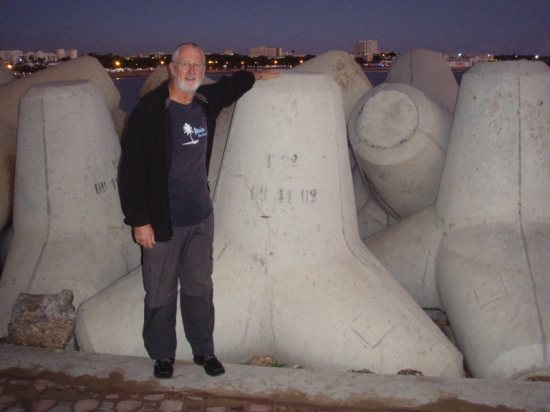 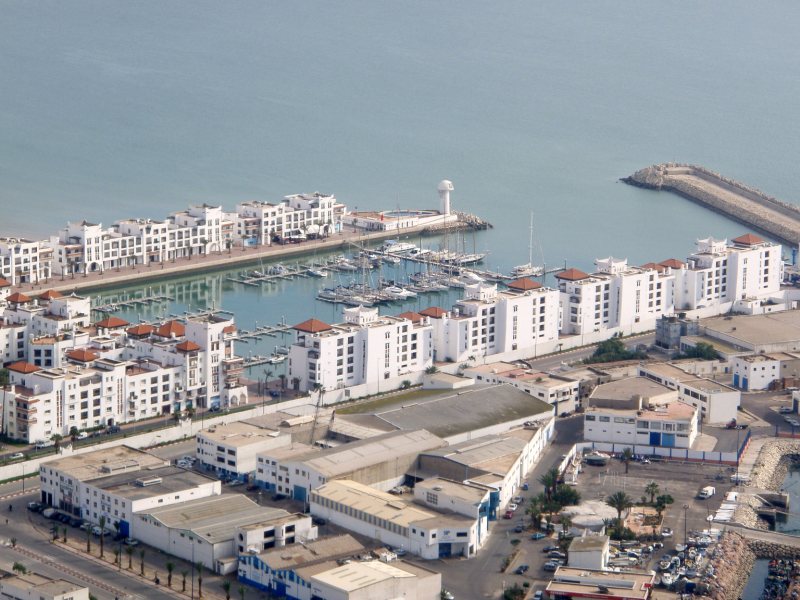
Usually when we see tetrapods they are way too far out for us
to get a close up. Not the most appealing photo, but great to "get down and dirty with a tetrapod" with them and show
their use with Agadir Marina.
All in all a useful bit of kit. A good way to stop fretting and
be busy during the night.
| 











